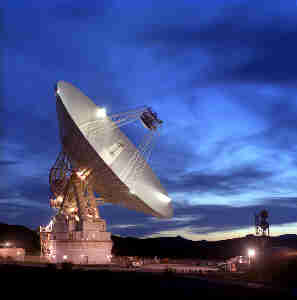By Patrick L. Barry
Call it a "buy one, get one free" sale for astronomers: Build a network of radio dishes for communicating with solar-system probes, get a world-class radio telescope with a resolution nearly as good as a telescope the size of Earth!
That's the incidental bonus that NASA's Deep Space Network (DSN) offers the astronomy community. Designed to maintain contact with distant spacecraft in spite of the Earth's rotation, the large, widely spaced dishes of the DSN are ideal for performing a form of radio astronomy called "very long baseline interferometry" (VLBI).
VLBI produces very high resolution images of the cosmos by combining the output from two or more telescopes. The result is like having a giant "virtual" telescope as large as the distance between the real dishes! Since bigger telescopes can produce higher resolution images than smaller ones, astronomers need to use dishes that are as far apart as possible.
That need dovetails nicely with the DSN's design. To maintain continuous contact with deep space missions, the DSN has tracking stations placed in California, Spain, and Australia. These locations are roughly equally spaced around the Earth, each about 120 degrees of longitude from the others-that way at least one dish can always communicate with a probe regardless of Earth's rotation. That also means, though, that the straight-line distance between any two of the stations is roughly 85 percent of Earth's diameter-or about 6,700 miles. That's almost as far apart as land-based telescopes can be.
"We often collaborate with other VLBI groups around the world, combining our dishes with theirs to produce even better images," says Michael J. Klein, manager of the DSN Science Office at NASA's Jet Propulsion Laboratory. "Since our 70-meter dish in Canberra, Australia, is the largest dish in the southern hemisphere, adding that dish in particular makes a huge difference in the quality of a VLBI observation."
Even though only about 1 percent of the DSN's schedule is typically spared from probe-tracking duty and scheduled for radio astronomy, it manages to make some important contributions to radio astronomy. For example, the DSN is currently helping image the expanding remnant of supernova 1987A, and Dr. Lincoln Greenhill of the Smithsonian Astrophysical Observatory is using the DSN dishes to explore a new way to measure the distances and velocities of galaxies.
And all this comes as a "bonus" from the dishes of the DSN.
To introduce kids to multi-wavelength astronomy, NASA's website for kids, The Space Place, has just added the interactive demo, "Cosmic Colors," at spaceplace.nasa.gov/cosmic .
This article was provided by the Jet Propulsion Laboratory, California Institute of Technology, under a contract with the National Aeronautics and Space Administration.


